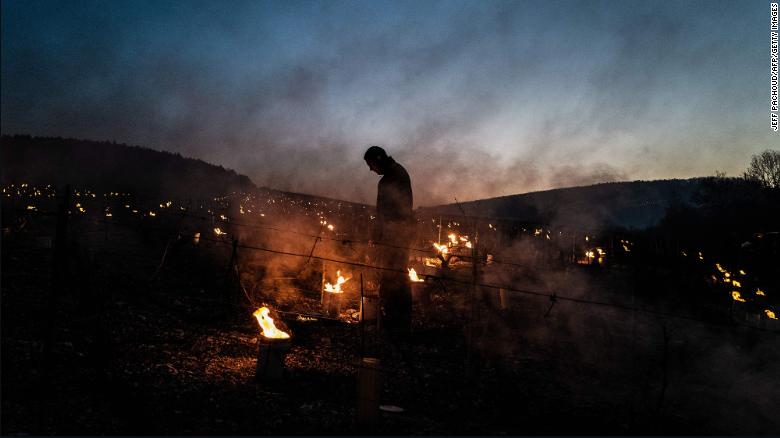

Notizie
French winemakers face devastation after worst weather in 30 years
One of France's biggest export industries is facing a devastating blow after an unusually severe frost earlier this month damaged vineyards across the country, heaping pain on winemakers already reeling from the pandemic and US tariffs.
The frost has affected 80% of vineyards in France's primary wine growing areas, according to the European Committee of Wine Companies. "This is expected to cause a yield loss ranging from 25% to up to 50% in some regions," the trade body told CNN Business on Wednesday.
The destruction spread across the Rhone Valley, Bordeaux, Burgundy, Champagne, Provence and the Loire Valley, said Anne Colombo, president of the Cornas appellation, a wine-growing area in the Rhone region.
"In some regions there will be very, very few grapes [this year]," she said, adding that the frost in Cornas is the worst in more than half a century.
Winemakers tried to keep air temperatures up by lighting candles and braziers in their vineyards, but in many cases it was not enough to protect their budding vines.
"An important share of the harvest has been lost. It's too early to give a percentage estimate, but in any case it's a tragedy for the winegrowers who have been hit," said Christophe Chateau, director of communications at the Bordeaux Wine Council.
The frost also threatens other crops, including beets and rapeseed, according to the National Federation of Farmers' Unions. "The anguish is immense in vineyards, orchards and fields," the organization said in a statement last week.
Not since 1991 have farms faced such a devastating weather event, according to French Prime Minister Jean Castex. Government spokesperson Gabriel Attal told journalists on Wednesday that in some areas "almost the whole annual production" of certain crops could be lost.
The French Ministry of Agriculture and Food last week activated its "agricultural calamities" program, triggering tax relief and other financial support measures for farmers. Government officials held an emergency meeting with bankers, insurers and agricultural representatives on Monday to identify additional support mechanisms.
"To you, the farmers, who all over France have fought tirelessly, night after night, to protect the fruits of your labor, I want to say that we give you our full support in this fight. Stand firm! We are at your side and will remain so," French President Emmanuel Macron said on Twitter.
The crisis comes at a particularly difficult time for French winemakers, who are suffering weaker sales as a result of coronavirus lockdowns in key international markets, the collapse of tourism due to the pandemic and US tariffs related to a dispute with the European Union over subsidies to planemakers Airbus (EADSY) and Boeing (BA).
Exports of French wine and spirits fell nearly 14% to €12.1 billion ($14.5 billion) in 2020, with sales to the United States tumbling 18%, according to the Federation of Wine and Spirits Exporters of France.
https://edition.cnn.com/2021/04/14/business/france-wine-production-losses/index.html
Das Neueste zum San Pietro Resort in Gjiri i Lalzit
Das San Pietro Resort stand im letzten Jahr 2021 an der Spitze aller Diskussionen im Zusammenhang mit der Region Gjiri i Lalzit.
Dieses wunderschön gestaltete Resort ist in Bezug auf seinen Bau sehr weit fortgeschritten und bereits große Teile des Wohngebietes sind fast fertiggestellt. Während einige Eigentümer entscheiden, welche Art von Fliesen in den Apartments und Villen installiert werden sollen, ordern andere bereits ihre Traumöbel bei lokalen Möbelherstellern.
Das Entwicklungsteam beschleunigt gleichzeitig sein Tempo, um die letzten Arbeiten rund um das Resort abzuschließen, damit im späten Frühling und frühen Sommer alle Dienstleistungen für den bevorstehenden Urlaub bereitgestellt werden können.
Die Preise der Immobilien sind seit Juli 2021 bis Ende letzten Jahres stark gestiegen:
Die Wohnungspreise von 1350-1400 Euro pro m2 im Sommer erreichten im November 2021 bis zu 1500-1600 Euro pro m2.
Jetzt werden Preise von 1450-1500 Euro pro m2 für alle Wohneinheiten in der 2. und 3. Reihe festgesetzt, während die erste Reihe der Apartments bei 1600 Euro pro m2 notiert wird.
Tatsache ist, dass trotz des starken Anstiegs der Preise in San Pietro die Verkäufe ihr Tempo beibehalten haben und Anfang des Jahres 2022 nur noch sehr wenige Einheiten zum Verkauf stehen und noch weniger Einheiten in günstigen Lagen mit Freiflächen.
The Latest on San Pietro Resort in Gjiri i Lalzit
San Pietro Resort was on the top of every discutions related to Gjiri i Lalzit area during last year 2021.
This beautifully designed resort has advanced very much with respect to its construction and already major parts of the residencial areas are almost completed with new residents deciding what kind of tiles to install in the apartments and villas and already hiring local teams of furniture producers to work on the furniture packages.
The developing team is accelerating their pace at the same time in order to finalize the last works around the resort so that in late Spring- early Summer all the services to the residents can have everything ready and accesible in their door-step for the upcoming holiday season in summer 2022.
Prices of the properties have been raising sharply starting in July through end of last year:
Apartment prices 1350-1400 Euro per 1 m2 back in summer reached as high as 1500-1600 Euro per 1 m2 in November 2021.
Now prices of 1450-1500 Euro per 1 m2 are set firm all accross all the palazinas in 2nd and 3rd line, while the front line of the palazinas are quoted at 1600 Euro per 1 m2.
Fact is the despite the sharp increase of the prices in San Pietro the sales continued to mentain their pace and at the begining of year 2022 it there are very few units left for sale, and even less units in favorable positions with open spaces between the four lines of palazinas.
Albania Property Group
03.01.2022










